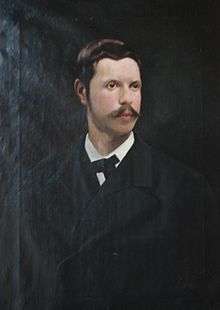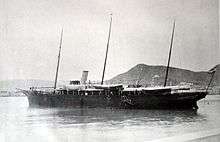Archduke Ludwig Salvator of Austria
| Archduke Ludwig Salvator | |||||
|---|---|---|---|---|---|
| Count of Neuendorf | |||||
 | |||||
| Born |
4 August 1847 Florence | ||||
| Died |
12 October 1915 (aged 68) Schloss Brandeis, Brandýs nad Labem-Stará Boleslav, Bohemia | ||||
| |||||
| House | House of Habsburg-Lorraine | ||||
| Father | Leopold II, Grand Duke of Tuscany | ||||
| Mother | Princess Maria Antonia of the Two Sicilies | ||||
Archduke Ludwig Salvator of Austria, in Italian Luigi Salvatore Maria Giuseppe Giovanni Battista Dominico Raineri Ferdinando Carlo Zenobio Antonino, in German Ludwig Salvator Maria Joseph Johann Baptist Dominicus Rainerius Ferdinand Carl Zenobius Antonin (Florence, 4 August 1847 - Schloss Brandeis, Brandýs nad Labem-Stará Boleslav, Bohemia, 12 October 1915), is known as a champion for Majorca's wildlife, in an era when the term "conservation" meant nothing. The Balearic Islands are commemorating the centenary of the death of Archduke Ludwig Salvator during 2015.
Ludwig Salvator settled on Majorca, buying up unimproved areas of land in order to preserve and enjoy them. His main residence of Son Marroig, near the village of Deià, is now a museum. Much of what was his property now belongs to the American actor Michael Douglas, notably the Moorish style palace 'S'Estaca' that Ludwig converted from a ruined old manor house.
About 1895, at Přerov nad Labem, Bohemia, he founded the first open-air museum in Central and Eastern Europe.
Works
He wrote a book on insects at the age of 22 and also the nine-volume book Die Balearen (The Balearic Islands).
Background
He was the second cousin of Emperor Franz Joseph, of the ruling House of Habsburg-Lorraine, the fourth son of Leopold II, Grand Duke of Tuscany. In his youth, he fell in love with Archduchess Mathilde, who was promised to Prince Umberto of Savoy. But she died accidentally; she was bored while watching a parade and tried to smoke a secret cigarette, her clothes caught fire and she literally burnt to death. Ludwig went to Majorca under his title of Count of Neuendorf, arriving in 1867. Falling in love with the clear air, water and dazzling blue skies of Majorca it was to become his base and home for the remainder of his life.

He explored on his steam-yacht the Nixe. He was known for his extreme love of animals and nature.
He never married. Relationships with women included Catalina Homar. She convinced Ludwig to let her visit Jerusalem and it is believed that it was there that she contracted the leprosy that took her life in 1905. He had many lovers, most of them Mallorcan and he sired many illegitimate children. He treated them as honoured children and gave them land and wealth. Nevertheless, someone spoke about his homosexuality, because of some letters that were sent to him from a supposed lover, who added pornographic sketches.
Ludwig's main work, his 9 volume book on the Balearics took 22 years to complete.
When the First World War broke out, in 1914, the Emperor of Austria ordered Ludwig Salvator to leave Majorca, and in 1915 he died at the family castle of Brandeis-Altbunzlau, in Bohemia. He was buried in Vienna.
Researcher and chronicler of the Mediterranean sea
It was of great importance to Ludwig Salvator to stimulate public interest for landscapes, which he thought were unjustifiably little known rarely traveled. His attention focused less on classical cultural centers, but on small, undiscovered regions, including the islands of Paxos and Antipaxos, Ithaca, Lefkada and Zakynthos in the Ionian Sea and the Aeolian Islands in the north of Sicily, the islands of Giglio, Ustica and Alboran, and especially the then largely unknown Balearic Islands of Mallorca, Menorca, Eivissa (Ibiza) and Formentera. In 1869, there appeared the first volume, dedicated to emperor Franz Joseph, of his massive Die Balearen. In Wort und Bild geschildert (The Balearic Islands, portrayed in words and images); the total work encompasses seven separate volumes extending to approximately 6000 pages. For their first two volumes he was awarded the gold medal of the Paris World Exhibition of 1878. This monograph contains descriptions of animals, plants, meteorology, history, folklore, architecture, landscape descriptions and also detailed descriptions of the population, their customs, songs and poems. In 1897 there was published a two-volume popular edition with the same title that contained the main illustrations and texts. It is located on loan from the Österreichische Geographische Gesellschaft (Austrian Geographical Society) in the Austrian State Archives. [1]
References
- Hammer, Ute. Oliver. Toniner and Schauhoff, Frank. 'Majorca: Culture and Life' Konemann Publishing
- ↑ Bibliothek Archived February 3, 2015, at the Wayback Machine. consulted on 26 September 2010
External links
| Wikimedia Commons has media related to Archduke Ludwig Salvator of Austria. |
- Menorca yesterday and today. Discovering Menorca with original engraving taken from Die Balearen. Archduke Ludwig Salvator of Austria.
- http://www.ludwig-salvator.com/